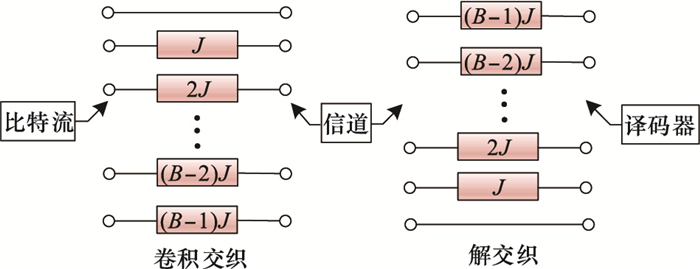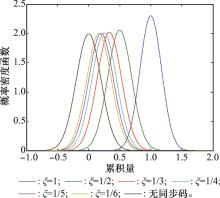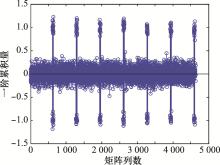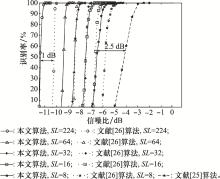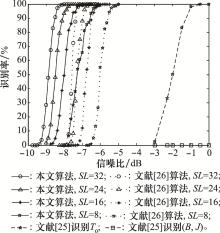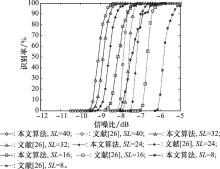Systems Engineering and Electronics ›› 2021, Vol. 43 ›› Issue (2): 546-554.doi: 10.12305/j.issn.1001-506X.2021.02.29
• Communications and Networks • Previous Articles Next Articles
Recognition of convolutional interleaver at low SNR
Zhaojun WU1,2( ), Limin ZHANG1(
), Limin ZHANG1( ), Zhaogen ZHONG3(
), Zhaogen ZHONG3( )
)
- 1. Institute of Information Fusion, Naval Aviation University, Yantai 264001, China
2. The Southwest Institute of Electronics and Telecommunications, Chengdu 610041, China
3. School of Basis Aviation, Naval Aviation University, Yantai 264001, China
-
Received:2019-12-18Online:2021-02-01Published:2021-03-16
CLC Number:
Cite this article
Zhaojun WU, Limin ZHANG, Zhaogen ZHONG. Recognition of convolutional interleaver at low SNR[J]. Systems Engineering and Electronics, 2021, 43(2): 546-554.
share this article
| 1 |
FORNEY G D . Burst-correcting codes for the classic bursty channel[J]. IEEE Trans.on Communication Technology, 1971, 19 (5): 772- 781.
doi: 10.1109/TCOM.1971.1090719 |
| 2 |
WU Z J , ZHANG L M , ZHONG Z G . A maximum cosinoidal cost function method for parameter estimation of RSC turbo codes[J]. IEEE Communications Letters, 2019, 23 (3): 390- 393.
doi: 10.1109/LCOMM.2018.2890224 |
| 3 |
DEBESSU Y G , WU H , JIANG H . Novel blind encoder parameter estimation for turbo codes[J]. IEEE Communications Letters, 2012, 16 (12): 1917- 1920.
doi: 10.1109/LCOMM.2012.102612.121473 |
| 4 |
YU P D , PENG H , LI J . On blind recognition of channel codes within a candidate set[J]. IEEE Communications Letters, 2016, 20 (4): 736- 739.
doi: 10.1109/LCOMM.2016.2525759 |
| 5 |
MOOSAVI R , LARSSON E G . Fast blind recognition of channel codes[J]. IEEE Trans.on Communications, 2014, 62 (5): 1393- 1405.
doi: 10.1109/TCOMM.2014.050614.130297 |
| 6 |
RAMABADRAN S , MADHU A S , GUOHUA W , et al. Blind recognition of LDPC code parameters over erroneous channel conditions[J]. IET Signal Processing, 2019, 13 (1): 86- 95.
doi: 10.1049/iet-spr.2018.5025 |
| 7 |
WU Z J , ZHANG L M , ZHONG Z G , et al. Blind recognition of LDPC codes over candidate set[J]. IEEE Communications Letters, 2020, 24 (1): 11- 14.
doi: 10.1109/LCOMM.2019.2953229 |
| 8 |
XIA T , WU H . Novel blind identification of LDPC codes using average LLR of syndrome a posteriori probability[J]. IEEE Trans.on Signal Processing, 2014, 62 (3): 632- 640.
doi: 10.1109/TSP.2013.2293975 |
| 9 |
IMAD R , SICOT G , HOUCKE S . Blind frame synchronization for error correcting codes having a sparse parity check matrix[J]. IEEE Trans.on Communications, 2009, 57 (6): 1574- 1577.
doi: 10.1109/TCOMM.2009.06.070445 |
| 10 |
XIA T , WU H . Blind identification of nonbinary LDPC codes using average LLR of syndrome a posteriori probability[J]. IEEE Communications Letters, 2013, 17 (7): 1301- 1304.
doi: 10.1109/LCOMM.2013.051313.130462 |
| 11 |
YARDI A D , VIJAYAKUMARAN S , KUMAR A . Blind reconstruction of binary cyclic codes from unsynchronized bitstream[J]. IEEE Trans.on Communications, 2016, 64 (7): 2693- 2706.
doi: 10.1109/TCOMM.2016.2561931 |
| 12 |
JO D , KWON S , SHIN D . Blind reconstruction of BCH codes based on consecutive roots of generator polynomials[J]. IEEE Communications Letters, 2018, 22 (5): 894- 897.
doi: 10.1109/LCOMM.2018.2806482 |
| 13 |
WU G , ZHANG B , GUO D , et al. Blind recognition of BCH codes in faster-than-Nyquist signalling system[J]. Electronics Letters, 2016, 52 (9): 716- 718.
doi: 10.1049/el.2015.4008 |
| 14 |
陈泽亮, 李静, 彭华, 等. 利用Gibbs采样进行优化的Turbo码交织器识别[J]. 电子学报, 2018, 46 (1): 15- 23.
doi: 10.3969/j.issn.0372-2112.2018.01.003 |
|
CHEN Z L , LI J , PENG H , et al. An optimization method using Gibbs sampler for turbo code interleaver identification[J]. Acta Electronica Sinica, 2018, 46 (1): 15- 23.
doi: 10.3969/j.issn.0372-2112.2018.01.003 |
|
| 15 | 吴昭军, 张立民, 钟兆根. 基于最大序列相关性的Turbo码交织器识别[J]. 航空学报, 2019, 40 (6): 322764. |
| WU Z J , ZHANG L M , ZHONG Z G . Blind recognition of interleaver for turbo codes based on maximum sequence correlation[J]. Acta Aeronautica et Astronautica Sinica, 2019, 40 (6): 322764. | |
| 16 | 刘骏, 李静, 于沛东. 一种Turbo码随机交织器的迭代估计方法[J]. 通信学报, 2015, 36 (6): 201- 206. |
| LIU J , LI J , YU P D . Iterative estimation method for random interleaver of turbo codes[J]. Journal on Communications, 2015, 36 (6): 201- 206. | |
| 17 | BUREL G, GAUTIER R. Blind estimation of encoder and interleaver characteristics in non-cooperative context[C]//Proc.of the International Conference on Communications, Internet and Information Technology, 2003: 17-19. |
| 18 |
SICOT G , HOUCKE S . Blind detection of interleaver parameters[J]. Signal Processing, 2009, 89 (4): 450- 462.
doi: 10.1016/j.sigpro.2008.09.012 |
| 19 | GAN L , LI D , LIU Z H , et al. A low complexity algorithm of blind estimation of convolutional interleaver parameters[J]. Science in China Series F: Information Sciences, 2012, 55 (10): 1- 9. |
| 20 | XU Y Y , ZHONG Y , HUANG Z P . An improved blind recognition method of the convolutional interleaver parameters in a noisy channel[J]. IEEE Access, 2019, (7): 101775- 101784. |
| 21 |
RAMABADRAN S , MADHUKUMAR A S , NG W T , et al. Parameter estimation of convolutional and helical interleavers in a noisy environment[J]. IEEE Access, 2017, 5, 6151- 6167.
doi: 10.1109/ACCESS.2017.2684189 |
| 22 |
SWAMINATHAN R , MADHUKUMAR A S . Classification of error correcting codes and estimation of interleaver parameters in a noisy transmission environment[J]. IEEE Trans.on Broadcasting, 2017, 63 (3): 463- 478.
doi: 10.1109/TBC.2017.2704436 |
| 23 | SWAMINATHAN R, MADHUKUMAR A S. Joint recognition of error correcting codes and interleaver parameters in a robust environment[C]//Proc.of the IEEE 27th Annual International Symposium on Personal, Indoor and Mobile Radio Communications, 2016: 1-6. |
| 24 | HUANG L, CHEN W G, CHEN H. Blind identification of helical interleaving of the first type[C]//Proc.of the IEEE 34th International Performance Computing and Communications Conference, 2015: 1-2. |
| 25 | 解辉, 王丰华, 黄知涛. 卷积交织器盲识别方法[J]. 电子与信息学报, 2013, 35 (8): 1952- 1957. |
| XIE H , WANG F H , HUANG Z T . A method for blind recognition of convolutional interleaver[J]. Journal of Electronics & Information Technology, 2013, 35 (8): 1952- 1957. | |
| 26 |
于沛东, 彭华, 巩克家, 等. 利用帧同步码的卷积交织器快速盲识别方法[J]. 电子学报, 2018, 46 (6): 1530- 1536.
doi: 10.3969/j.issn.0372-2112.2018.06.038 |
|
YU P D , PENG H , GONG K J , et al. Fast blind recognition of convolutional interleavers based on existence of frame sync codes[J]. Acta Electronica Sinica, 2018, 46 (6): 1530- 1536.
doi: 10.3969/j.issn.0372-2112.2018.06.038 |
| [1] | Jianxing LIU, Tianqi ZHANG, Haojun BAI, Shaopeng YE. Blind recognition algorithm of polar code based on information matrix estimation [J]. Systems Engineering and Electronics, 2022, 44(2): 668-676. |
| [2] | He LI, wenjing ZHAO, Minglu JIN. Improved spectrum sensing algorithms based on high order moments of eigenvalues [J]. Systems Engineering and Electronics, 2022, 44(10): 3243-3248. |
| [3] | Bo SONG, Wei YE, Xianghui MENG. Review of multi-agent reinforcement learning based dynamic spectrum allocation method [J]. Systems Engineering and Electronics, 2021, 43(11): 3338-3351. |
| [4] | Yuyuan ZHNAG, Wenjun YAN, Limin ZHANG, Yuan ZHANG. Blind recognition algorithm of serial space-time block code based on convolutional neural network [J]. Systems Engineering and Electronics, 2021, 43(11): 3360-3370. |
| [5] | Qing LING, Wenjun YAN, Limin ZHANG, Keyuan YU. Blind signal recognition method of AL-OFDM and SM-OFDM space-frequency block codes [J]. Systems Engineering and Electronics, 2021, 43(1): 19-25. |
| [6] | Tianqi ZHANG, Congcong FAN, Shengqi YU, Jiangen ZHAO. Blind recognition of orthogonal and non-orthogonal space-time block codes based on JADE and feature extraction [J]. Systems Engineering and Electronics, 2020, 42(4): 933-939. |
| [7] | Shengnan YAN, Mingxin LIU. Distributed cooperative compressed spectrum sensing scheme based on support set fusion [J]. Systems Engineering and Electronics, 2020, 42(2): 466-472. |
| [8] | Yuan LUO, Jiaojiao DANG, Zuxun SONG, Baoping WANG. Achieving adaptive compressive spectrum sensing for cognitive radio [J]. Systems Engineering and Electronics, 2020, 42(1): 15-22. |
| [9] | MIAO Chenglin, LI Tong, LYU Jun, CHANG Cheng. Research on dynamic frequency hopping channel access algorithm based on hidden Markov model [J]. Systems Engineering and Electronics, 2019, 41(8): 1873-1880. |
| [10] | ZHANG Mengbo, WANG Lunwen, FENG Yanqing. Distributed cooperative spectrum sensing method based on reinforcement learning and consensus fusion [J]. Systems Engineering and Electronics, 2019, 41(3): 486-492. |
| [11] | ZHANG Mengbo, WANG Lunwen, FENG Yanqing . Coalitional game based distributed cooperative spectrum sensing method in cognitive wireless network [J]. Systems Engineering and Electronics, 2019, 41(2): 236-243. |
| [12] | LONG Lang, YANG Jun’an, LIU Hui, LIANG Zongwei. Blind identification of convolutional interleaver parameters based on zeromeanratio for common data link#br# [J]. Systems Engineering and Electronics, 2018, 40(8): 1702-1707. |
| [13] | ZHANG Haibo, ZHANG Jin, LI Fangwei. User selected collaborative spectrum sensing based on energy detection [J]. Systems Engineering and Electronics, 2018, 40(3): 658-664. |
| [14] | REN Xiaoyue, CHEN Changxing. Adaptive access control strategy of cognitive radio wireless sensor network [J]. Systems Engineering and Electronics, 2017, 39(9): 2100-2108. |
| [15] | REN Xiaoyue, CHEN Changxing. Energy efficient collaborative spectrum sensing strategy against malicious users in cognitive radio networks [J]. Systems Engineering and Electronics, 2017, 39(6): 1347-1357. |
| Viewed | ||||||
|
Full text |
|
|||||
|
Abstract |
|
|||||

